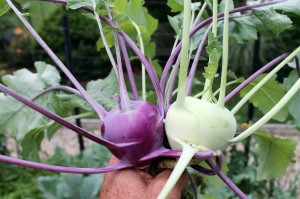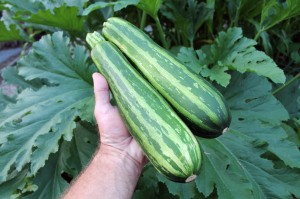Weirdo Vegetable Report
November 12th, 2013
One of the best parts about home veggie gardening is that you get to try all sorts of things that don’t show up at the grocery store.
Usually, the no-shows are no-shows because they don’t ship well, keep well or look good on the shelves.
Sometimes it’s because a particular edible isn’t well known or just never caught on, so demand is too low to make it worth carrying.
And sometimes it’s because the plant just plain tastes crappy.
Gardeners with inquiring minds want to know which it is. So as we gardeners morph from beginner to experienced to lunatic, we try most anything and everything – just to see what it’s all about.
For me, this year meant trying white beets, black radishes, artichokes, an improved duo of kohlrabi, a new variety of striped zucchini and Malabar spinach. The results…
The white ‘Blankoma’ beets sounded like an interesting alternative to traditional red ones. Maybe they’d have a vanilla flavor?
Actually, they didn’t grow well at all. The leaves bulked up nicely, but the roots were uneven in size and tasted more like dirt than beets to me. Scratch that one.
‘Nero Tondo’ is a black Spanish type of radish with white flesh and black skin. I grew a pack next to my usual red ‘Early Scarlet Globe’ and ‘Pink Beauty.’
‘Nero Tondo’ took a couple of weeks longer to size up. I sampled a few and found them to be hard, woody and hotter than many hot peppers. It was like eating a wooden door knob soaked in hot-pepper sauce.
Meanwhile, my old standbys produced one of my best crops ever of mild, thumb-sized radishes.
‘Imperial Star’ artichokes were touted as ‘chokes you could start inside from seed and get a harvestable crop the same year in our growing zone. The seeds germinated, and the plants grew reasonably well and actually looked nice with their silvery, upright leaves most of the summer.
I grew four of them, and none even hinted at producing a flower – much less an edible globe.
I wasn’t expecting much of a harvest since artichokes aren’t prolific yielders even in ideal situations (which is why they’re so expensive). But zero was on the low end of even my meager expectation. Maybe I’ll grow these again as an ornamental.
The highlight of the newbies was the ‘Crispy Colors Duo’ kohlrabi I got from Renee’s Garden Seeds. This is a mix of purple and cream-colored kohlrabi, which are like handball-sized mild turnips that grow at the soil surface with stems coming out all around them. They look like something from another planet to me.
‘Crunchy Colors Duo’ turned out to be the best performing and best tasting kohlrabi I’ve ever grown. The cabbagey/turnipy flavor was sweet and mild, and the texture was perfectly crispy without any of the woodiness that can happen in other varieties (yeah, you, ‘Early Purple Vienna’).
Another winner was a new variety of zucchini-type summer squash called ‘Green Tiger’ that I got from Harris Seeds.
The most striking part about this one is the alternating dark-green and light-green stripes that run end to end on ‘Green Tiger’ fruits. Interesting look.
But ‘Green Tiger’ was fast to get busy, producing the first two pickable-sized zukes just 5 weeks after direct-seeding them in the garden.
By mid-summer, squash vine borers attacked the base of my two plants as usual. I figured they’d be goners within a few weeks, which is why I always have a second, ensuing planting waiting to take over once the front-runners croak. Though the main stems looked gnarly and some of the plants died back, enough grew on to valiantly produce adequate zukes right into frost. What a fighter! I give ‘Green Tiger’ a purple heart.
And finally, there was the Malabar spinach. If you’re familiar with this one, you know it’s not a spinach at all but a climbing vine that produces finger-nail-sized, succulent, green, edible leaves, pinkish-lavender flowers and purplish stems.
It’s a good-looking annual vine and one I grew mainly for ornamental purposes up the arbor leading into my four-square vegetable garden.
I use the term “edible” loosely for this one. Maybe some people like the flavor and texture of Malabar spinach, which is usually described as “fleshy” or “mucilaginous.” I’d call it more like “slimy” and “weed-flavored.”
Malabar spinach is super-easy to grow, tolerant of blow-torch heat and attractive throughout summer. In my opinion, though, it’s better left on the arbor than added to a salad.











